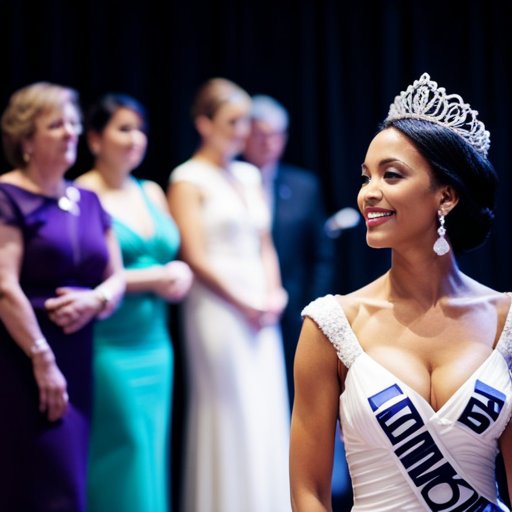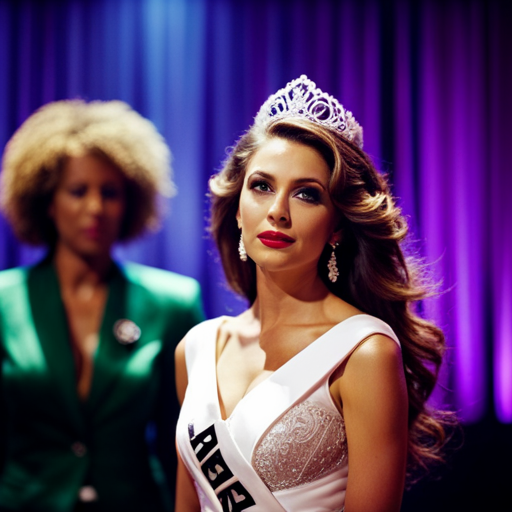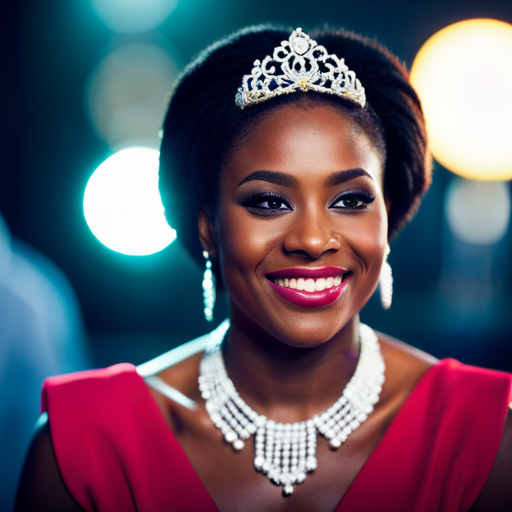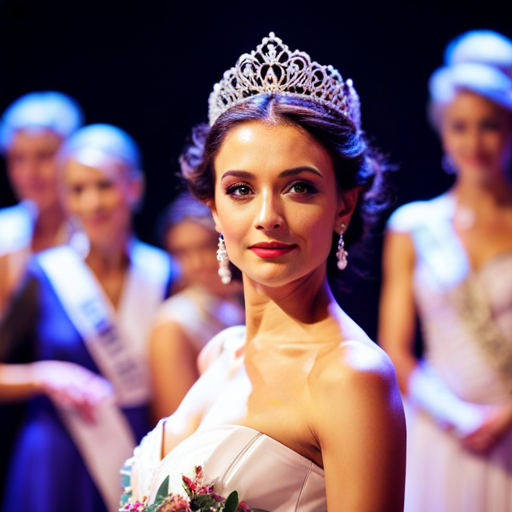The Power of Body Language in Beauty Pageants
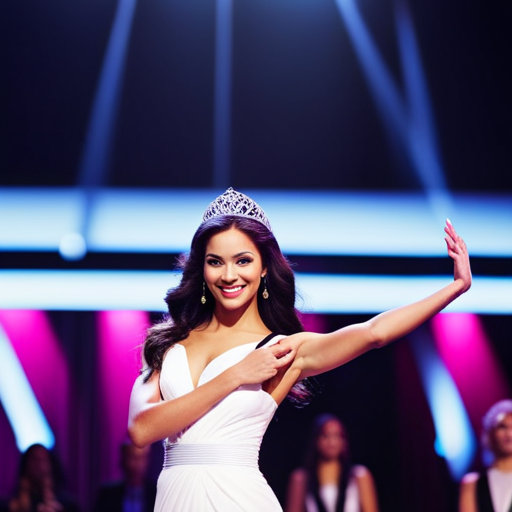
In the world of beauty pageants, the power of body language cannot be overstated. It is not merely about the way one looks, but also about how one carries oneself on stage.
The subtle nuances of non-verbal communication play a crucial role in making a lasting impression. From posture and poise to gestures and expressions, every aspect of body language contributes to the overall performance.
Mastering the art of body language is indispensable for success in the realm of beauty pageantry.
Importance of Body Language in Beauty Pageants
Emphasizing confident and graceful body language is crucial for contestants to make a lasting impression in beauty pageants. The impact of body language on stage presence is undeniable. Nonverbal communication, including posture, gestures, and facial expressions, plays a pivotal role in conveying confidence signals to the judges and the audience.
A contestant’s ability to command the stage with poise and elegance through their body language can set them apart from the competition. The way a contestant walks, stands, and uses hand movements can communicate volumes about their self-assurance and charisma.
Moreover, body language can also express a contestant’s inner strength and determination, which are essential qualities in a beauty pageant. It is not just about how the contestant looks, but also about how they carry themselves and engage with the audience without uttering a single word. Mastering the art of body language can elevate a contestant’s performance and leave a lasting impression on the judges.
Transitioning into the subsequent section about ‘non-verbal communication in pageant performance’, it is evident that body language is an integral part of a contestant’s overall stage presence and can significantly influence their success in beauty pageants.
Non-verbal Communication in Pageant Performance
Non-verbal communication plays a pivotal role in shaping a contestant’s stage presence and overall performance in beauty pageants. In the high-stakes environment of a beauty pageant, non-verbal cues can often speak louder than words, influencing judges’ perceptions and audience engagement.
Here are three key aspects of non-verbal communication that significantly impact a contestant’s pageant performance:
-
Body Language: A contestant’s posture, gestures, and facial expressions can convey confidence, poise, and grace, or alternatively, reveal nervousness and discomfort. Maintaining graceful and poised body language throughout the pageant performance is crucial for leaving a lasting impression on the judges and audience.
-
Eye Contact: Establishing and maintaining meaningful eye contact with the judges and audience members can communicate sincerity, confidence, and a genuine connection. Eye contact is a powerful non-verbal tool that can captivate the audience and convey the contestant’s charisma and authenticity.
-
Facial Expressions: Expressive and emotive facial expressions can effectively convey the contestant’s inner emotions, personality, and passion for the pageant. Genuine and well-timed smiles, along with appropriate expressions that resonate with the performance, can create a strong emotional connection with the audience, leaving a memorable impact.
Impact of Posture and Poise on Stage
The contestant’s posture and poise on stage are crucial elements that contribute to their overall non-verbal communication and can significantly influence the judges’ and audience’s perceptions.
Body language impact and confidence are conveyed through a contestant’s posture and stage presence. A straight and upright posture exudes confidence and grace, instantly capturing the attention of the judges and audience. It signifies strength, self-assurance, and a commanding presence on the stage.
Additionally, poise, which encompasses graceful and controlled movements, further enhances the contestant’s overall stage performance, leaving a lasting impression. It is essential for contestants to maintain consistent posture and poise throughout the pageant, as it reflects their ability to handle pressure and remain composed in various situations.
Moreover, a strong stage presence creates a sense of connection with the audience, allowing the contestant to establish a captivating and memorable performance.
Transitioning into the subsequent section about ‘gestures and expressions: communicating confidence’, it is clear that posture and poise lay the foundation for effective non-verbal communication in beauty pageants.
Gestures and Expressions: Communicating Confidence
In beauty pageants, gestures and expressions play a crucial role in conveying confidence.
Nonverbal signals such as posture, facial expressions, and body language are key indicators of a contestant’s self-assurance on stage.
Understanding the impact of these elements is essential for contestants to effectively communicate confidence to the judges and the audience.
Nonverbal Confidence Signals
Communicating confidence through gestures and expressions is a crucial aspect of body language in beauty pageants. Nonverbal signals such as posture confidence and stage presence play a significant role in conveying a contestant’s self-assurance and poise on stage.
Here are some key points to consider:
-
Posture Confidence: A straight posture with shoulders back and head held high exudes confidence and assertiveness, making a contestant appear more self-assured and in control.
-
Stage Presence: Confident body language on stage, such as making deliberate movements and maintaining eye contact with the audience and judges, can captivate attention and leave a lasting impression.
-
Facial Expressions: Smiling, maintaining a pleasant and composed facial expression, and using eye contact effectively can convey confidence and charisma, enhancing the overall stage presence.
Impact of Facial Expressions
Facial expressions play a significant role in conveying a contestant’s confidence and charisma on stage in beauty pageants. Nonverbal communication, including facial expressions, has a profound emotional impact on the audience and judges.
A warm and genuine smile can instantly make a contestant appear more approachable and likable, while a furrowed brow or tense jawline may convey nervousness or discomfort. The ability to maintain a composed and pleasant facial expression throughout various segments of the competition demonstrates the contestant’s stage presence and ability to connect with the audience.
Whether it’s exuding joy during the talent portion or projecting determination during the Q&A segment, these facial expressions are crucial in communicating confidence and leaving a lasting impression.
Now, let’s delve into the significance of body language and poise in beauty pageants.
Body Language and Poise
Demonstrating graceful gestures and confident expressions through body language is pivotal for contestants to convey their poise and charisma on the beauty pageant stage. This non-verbal communication plays a crucial role in creating a lasting impression and showcasing the contestant’s stage presence.
To achieve this, contestants should focus on:
- Maintaining an upright posture to exude confidence and elegance.
- Keeping movements fluid and controlled to demonstrate grace and composure.
- Using facial expressions that convey warmth, sincerity, and self-assuredness.
These elements collectively contribute to the contestant’s overall presentation, leaving a lasting impact on the judges and audience. By mastering these aspects of body language and poise, contestants can elevate their performance and leave a memorable impression on the pageant stage.
Walking the Walk: Mastering the Pageant Strut
Mastering the pageant strut requires a precise balance of grace, poise, and confidence. The pageant walk is not just about moving from one point to another; it’s a display of elegance and self-assuredness. The way a contestant carries herself on the runway can make a lasting impression on the judges and the audience. It’s essential for contestants to exude runway confidence and captivate everyone with their poise. The right posture, stride, and attitude can make a significant difference in how the walk is perceived.
| Key Elements of Mastering the Pageant Strut |
|---|
| 1. Posture |
| 2. Stride |
| 3. Attitude |
| 4. Confidence |
| 5. Elegance |
Posture is crucial for a commanding presence, while the stride should be graceful, yet purposeful. Attitude plays a pivotal role in conveying confidence and charisma. Confidence is the key to owning the stage, and elegance adds a touch of sophistication to the overall presentation. Mastering these elements can elevate a contestant’s performance and leave a lasting impression.
Connecting With Judges and Audience Through Body Language
To truly connect with judges and audience members in a beauty pageant, contestants must exude confidence and poise through their body language.
Non-verbal communication techniques such as maintaining eye contact, open gestures, and a genuine smile can greatly impact how the contestants are perceived on stage.
It’s crucial for contestants to convey authenticity in their stage presence, as this can make a significant difference in how they are perceived by both judges and the audience.
Confidence and Poise Impact
With the right body language, beauty pageant contestants can effectively connect with both judges and the audience, conveying confidence and poise.
A confident presence is crucial for creating a lasting impact on the judges and audience. Maintaining eye contact exudes confidence and shows that the contestant is composed and self-assured. Standing tall with good posture signifies assurance and projects a strong, confident image to the judges and audience.
Graceful movements can captivate the audience and leave a memorable impression. Smooth and controlled gestures demonstrate elegance and sophistication, enhancing the overall poise of the contestant. Fluid transitions and poised walking convey a sense of grace and refinement, drawing attention and admiration from both judges and the audience.
Non-Verbal Communication Techniques
Effective communication in beauty pageants extends beyond verbal expression; contestants must master the art of non-verbal communication to connect with judges and captivate the audience. Nonverbal communication plays a crucial role in conveying confidence, grace, and charisma on stage. However, it’s essential to acknowledge cultural differences in interpreting body language to ensure a universal appeal. Moreover, body language can challenge gender stereotypes, as contestants use gestures and posture to portray strength, elegance, and intelligence, breaking traditional expectations. Below is a table illustrating non-verbal communication techniques and their impact on judges and the audience:
| Non-Verbal Communication Techniques | Impact on Judges | Impact on Audience |
|---|---|---|
| Eye contact | Conveys confidence | Builds rapport |
| Posture | Reflects poise | Captures attention |
| Gestures | Expresses emotion | Enhances engagement |
Mastering nonverbal communication is a powerful tool for contestants to leave a lasting impression on judges and the audience, transcending cultural and gender boundaries.
Authenticity in Stage Presence
In stage presence, authenticity is conveyed through genuine and compelling body language, establishing a strong connection with judges and the audience.
-
Non-verbal cues: Authenticity in stage presence is communicated through non-verbal cues such as eye contact, facial expressions, and posture, which convey confidence and sincerity to the judges and audience.
-
Emotional resonance: Genuine emotions expressed through body language create an authentic connection with the audience, allowing them to resonate with the performer’s stage presence and experience the depth of the performance.
-
Consistency: Authenticity in stage presence requires consistency in body language, aligning with the emotions and message being conveyed, ensuring a genuine and believable performance that captivates the judges and audience.
In beauty pageants, the ability to authentically connect with the judges and audience through compelling body language is a crucial aspect of a contestant’s stage performance.
Body Language Tips for Pageant Success
To achieve success in beauty pageants, it is essential to project confidence and poise through precise and intentional body language. Pageant performance relies heavily on non-verbal communication, and mastering body language can significantly impact a contestant’s overall stage presence. Here are some key body language tips for pageant success:
| Body Language Tips | Description | Example |
|---|---|---|
| Maintain Good Posture | Stand tall with shoulders back and down | Imagine a string pulling you up from the crown |
| Eye Contact | Establish eye contact to connect with the audience | Look directly into the eyes of the judges and audience members |
| Smile Naturally | Smile warmly and genuinely | Practice smiling in front of a mirror to find your most natural smile |
| Controlled Movements | Use graceful and controlled movements | Practice walking in heels to ensure smooth, confident strides |
| Open Gestures | Use open gestures to appear approachable | Keep your arms relaxed and use expressive hand movements |
Mastering these body language techniques will help contestants exude confidence signals, leaving a lasting impression on judges and the audience.
Frequently Asked Questions
What Are Some Common Mistakes Contestants Make With Their Body Language During Beauty Pageants?
Common mistakes in beauty pageants include poor nonverbal communication and lack of confident presence. Subtle cues like slouching, lack of eye contact, or fidgeting can detract from contestant’s overall performance and impact their success.
How Can Contestants Use Their Body Language to Stand Out From the Competition?
Contestants can stand out from the competition by exuding confidence and showcasing graceful movements. These qualities are essential in capturing attention and leaving a lasting impression on judges and the audience in beauty pageants.
Are There Specific Gestures or Expressions That Judges Look for During Pageant Performances?
When evaluating contestants during pageant performances, judges often look for specific nonverbal communication cues and expressions as part of their judging criteria. These include confident body language, graceful movements, and strong stage presence.
How Can Contestants Improve Their Posture and Poise for Stage Presence?
Improving posture and poise for stage presence demands deliberate practice. Enhancing confidence through upright posture and gracefulness in movement is essential. Engage in regular exercises and seek professional coaching for a poised and confident stage presence.
What Are Some Tips for Effectively Connecting With Both Judges and the Audience Through Body Language?
To effectively connect with judges and the audience through body language, contestants should focus on non-verbal communication, exuding confidence, maintaining strong stage presence, and engaging the audience with eye contact and expressive gestures.
Conclusion
In conclusion, the power of body language in beauty pageants cannot be underestimated. Research shows that 55% of communication is non-verbal, making body language a crucial aspect of pageant performance.
Mastering posture, gestures, and the pageant strut can greatly impact a contestant’s success on stage. By understanding the importance of non-verbal communication and implementing body language tips, contestants can effectively connect with judges and the audience, ultimately enhancing their overall pageant performance.
